Maricopa County voters will decide this November whether to continue a sales tax extension that funds new highways, roads and bus routes.
What is Proposition 479?Proposition 479 asks voters to continue the half-cent sales tax for the next 20 years. Voters first approved the measure in 1985 and then again in 2004. The tax, equal to 1 cent for every $2 spent, funds regional transportation plans approved by mayors across the Valley. Taxes account for $14.9 billion of the $28.2 billion plan, or just over half.
what does it do? This tax alone would fund highways (40.5%), bus transit and bus rapid transit (33.5%), major roads and regional transportation infrastructure (22.5%), and light rail maintenance (3.5%). . But when combined with other funding sources, it frees up revenue for the cities of Phoenix, Mesa and Tempe, and billions of dollars in federal funds to expand 19.9 miles of light rail and 7.4 miles of streetcar. . It may be better known by its former name, Proposition 400.
Here’s what you need to know:
The costs of Proposition 479 are:
- 331 additional highway and freeway lane miles
- 134 new HOV lane miles
- 1,000 new or improved highway miles
- and 43 new or improved transportation interchanges.
Who decided on the transportation plan?
The plan was developed by city, state and business leaders who make up the Maricopa Association of Governments’ Regional Transportation Policy Committee, with the goal of preventing further traffic congestion and protecting existing infrastructure. A quasi-governmental agency, MAG supports regional planning primarily related to transport, but also housing, human services, and the environment.
The plan was unanimously approved by a committee of city, county and tribal leaders and MAG’s regional council.
How does Proposition 479 affect you personally?
The Maricopa Association of Governments touts that its regional transportation plan will keep the region’s average commute time down to 30 minutes by 2050. That comes after the county’s population is projected to grow by 2 million people and add 900,000 jobs.
Who is opposed to Proposition 479 and why?
The Arizona Free Enterprise Club and the Goldwater Institute oppose Proposition 479 because they hate light rail.
Scott Mussi, president of the Free Enterprise Club, called the plan a “transportation slush fund disguised as a transportation plan,” arguing that it would divert nearly as much money to light rail as highways. “40% of this new tax increase will fund more light rail projects,” said Victor Riches of the Goldwater Institute.
However, these comments are inaccurate. The plan allocates 37% of the revenue to public transit, but only 3.5% goes to light rail. The purpose of light rail is limited to maintenance and cannot be expanded.
What’s true is that approval of Proposition 479 will allow cities to expand light rail. That’s because increased local funding for roads and bus service would allow Phoenix, Tempe, and Mesa revenue to go towards light rail.
Major projects planned if Proposition 479 is approved
- A new freeway interchange is under construction between Interstate 17 and Loop 303 in north Phoenix near Taiwan Semiconductor Manufacturing Company.
- Construction of State Route 30 begins. This is a new highway a few miles south that parallels Interstate 10 and will be fully built out to connect Buckeye and Phoenix.
- State Route 24 to Ironwood Drive southeast of Mesa is completed.
- Improvements have been made to the Jackrabbit Trail and Interstate 10 interchange in Buckeye.
- Grand Avenue/US 60 will be upgraded from Surprise to downtown Phoenix.
- Widening section of Loop Routes 101, 202, and 303.
- It serves the 35th Street and Van Buren Street bus rapid transit routes in Phoenix and Scottsdale, as well as rural roads in Scottsdale and Tempe.
Taylor Seely covers Phoenix for The Arizona Republic/azcentral.com. please contact her tseely@arizonarepublic.com or call 480-476-6116.
















